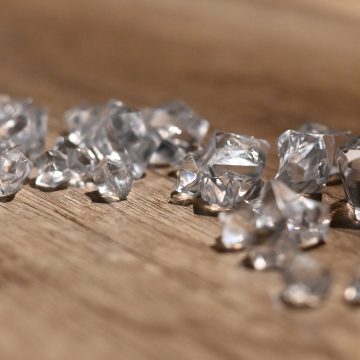
Diamonds, with their unparalleled brilliance and timeless allure, have captivated humanity for centuries. But have you ever wondered where these precious gemstones come from? Join us on a fascinating journey as we uncover the mysteries behind the origin of diamonds, exploring their geological formation, extraction, and journey from deep within the Earth to adornment in exquisite jewelry.
Geological Formation
Contrary to popular belief, diamonds aren’t born from the pressure of coal. Instead, they form deep within the Earth’s mantle, where intense heat and pressure transform carbon atoms into crystalline structures over millions of years.
This process begins approximately 100 miles below the Earth’s surface, where volcanic activity transports diamond-bearing rocks, known as kimberlite or lamproite, to shallower depths. As these magma chambers cool and solidify, they create the ideal conditions for diamonds to crystallize and grow.
Extraction and Mining
 Once diamonds have formed deep within the Earth, they must be brought to the surface through a process of extraction and mining. This often involves a combination of open-pit mining, underground mining, and alluvial mining techniques, depending on the geological characteristics of the deposit.
Once diamonds have formed deep within the Earth, they must be brought to the surface through a process of extraction and mining. This often involves a combination of open-pit mining, underground mining, and alluvial mining techniques, depending on the geological characteristics of the deposit.
In open-pit mining, large machinery is used to remove the earth and rock covering the diamond-bearing ore body. Underground mining involves tunneling into the Earth to access deeper deposits, while alluvial mining relies on the natural erosion of diamond-bearing rocks and sediments by rivers and streams.
Global Diamond Sources
Diamonds are found on every continent, but the majority of commercial diamond production comes from a handful of key regions around the world. Some of the most significant diamond-producing countries include:
- Africa: Africa is home to some of the world’s largest and most prolific diamond mines, including those in Botswana, South Africa, Angola, and the Democratic Republic of the Congo.
- Russia: Russia is another major player in the global diamond industry, with significant diamond deposits found in Siberia and the Arkhangelsk region.
- Australia: Australia boasts several diamond mines, particularly in the Kimberley region of Western Australia and the Northern Territory.
- Canada: Canada is renowned for its high-quality diamonds, with major mines located in the Northwest Territories and Ontario.
Diamonds in Jewelry
Once diamonds have been extracted from the Earth and processed into rough crystals, they undergo a series of cutting, polishing, and grading processes to unlock their full brilliance and beauty. Master craftsmen and artisans carefully shape each diamond into exquisite gemstones, ready to adorn the finest jewelry creations.

From dazzling engagement rings to elegant necklaces, bracelets, and earrings, diamonds have long been cherished as symbols of love, luxury, and prestige. Their enduring beauty and timeless appeal make them a prized possession for generations to come.
Conclusion
The journey of a diamond from deep within the Earth to its place of prominence in jewelry is a testament to nature’s remarkable beauty and the ingenuity of humankind. By understanding the geological processes, extraction methods, and global sources of diamonds, we gain a deeper appreciation for these extraordinary gemstones and the stories they hold within.
Whether adorning a special occasion or cherished as a treasured heirloom, diamonds continue to captivate hearts and minds with their unparalleled brilliance and enduring allure. As we marvel at their beauty, let us also reflect on the extraordinary journey that brings these precious gems from the depths of the Earth to grace our lives with sparkle and splendor.

